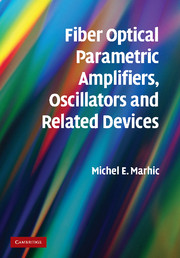Book contents
- Frontmatter
- Contents
- Acknowledgments
- 1 Introduction
- 2 Properties of single-mode optical fibers
- 3 Scalar OPA theory
- 4 Vector OPA theory
- 5 The optical gain spectrum
- 6 The nonlinear Schrödinger equation
- 7 Pulsed-pump OPAs
- 8 OPO theory
- 9 Quantum noise figure of fiber OPAs
- 10 Pump requirements
- 11 Performance results
- 12 Potential applications of fiber OPAs and OPOs
- 13 Nonlinear crosstalk in fiber OPAs
- 14 Distributed parametric amplification
- 15 Prospects for future developments
- Appendices
- Index
- References
14 - Distributed parametric amplification
Published online by Cambridge University Press: 23 March 2010
- Frontmatter
- Contents
- Acknowledgments
- 1 Introduction
- 2 Properties of single-mode optical fibers
- 3 Scalar OPA theory
- 4 Vector OPA theory
- 5 The optical gain spectrum
- 6 The nonlinear Schrödinger equation
- 7 Pulsed-pump OPAs
- 8 OPO theory
- 9 Quantum noise figure of fiber OPAs
- 10 Pump requirements
- 11 Performance results
- 12 Potential applications of fiber OPAs and OPOs
- 13 Nonlinear crosstalk in fiber OPAs
- 14 Distributed parametric amplification
- 15 Prospects for future developments
- Appendices
- Index
- References
Summary
Introduction
During recent years much research has been performed with the aim of developing fiber Raman amplifiers. Some work was done on discrete Raman amplifiers, but now it appears that the best way to utilize Raman gain is in distributed amplification, i.e. the amplification of communication signals along transmission fibers rather than in discrete amplifiers located between such fibers. Some system manufacturers have developed long-haul systems based on distributed Raman amplification (DRA). Such systems, however, generally require high pump powers, sometimes in excess of 1 W, and this raises concerns about safety and reliability.
Concerning fiber OPAs, to date most efforts have concentrated on discrete devices, i.e. subsystems that could eventually be used as a substitute for other discrete optical amplifiers, such as erbium-doped fiber amplifiers (EDFAs) [1, 2]. Raman and parametric fiber amplification are related third-order nonlinear phenomena, which occur in common silica fibers in the presence of strong optical pumps. Whether a particular amplification mechanism is best suited for discrete or distributed amplification depends on a number of parameters, such as the gain bandwidth, the required pump power, the noise characteristics, etc.
Distributed parametric amplification (DPA) has previously been investigated as a detrimental effect, because strong carriers can further amplify in transmission fibers the amplified spontaneous emission (ASE) generated by the discrete EDFAs used to amplify signals between fiber spans. This has been done for one-pump [3–19] and two-pump [20] parametric amplification.
Information
- Type
- Chapter
- Information
- Publisher: Cambridge University PressPrint publication year: 2007
